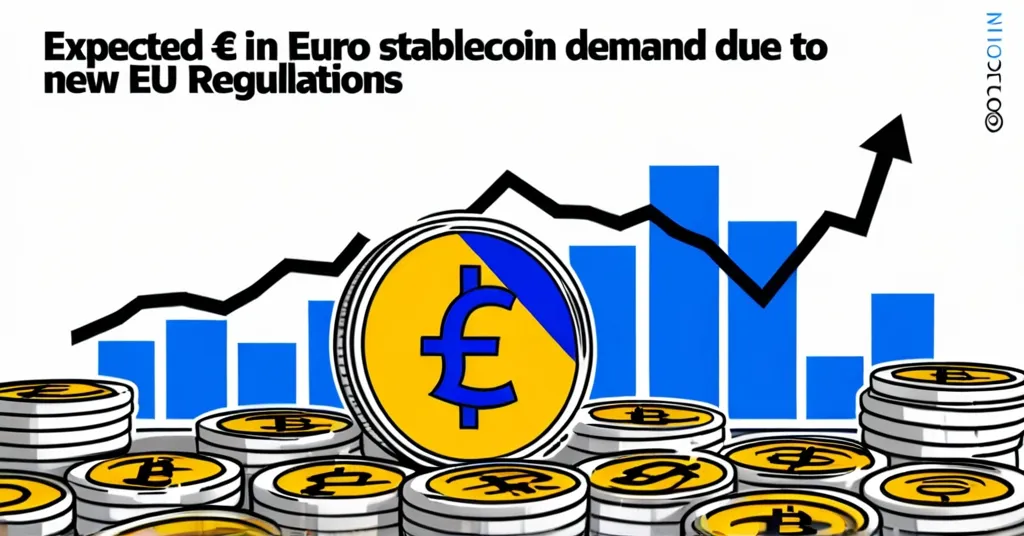EU’s MiCA Regulations to Surge Euro Stablecoin Demand, Says JPMorgan

EU’s MiCA Regulations Set to Boost Euro Stablecoins: JPMorgan’s Forecast
JPMorgan predicts a significant rise in the demand for euro-denominated stablecoins due to the EU’s new MiCA regulations, which took effect on December 30, 2024. Despite initial concerns in the crypto community, these regulations are poised to encourage European financial institutions to adopt euro stablecoins, potentially increasing their market share from 0.12%.
- MiCA regulations effective Dec 30, 2024
- Expected boost for euro stablecoins
- Compliance mandates affecting global players
- Exclusion of algorithmic stablecoins
MiCA’s primary aim is to protect financial stability and attract institutional investors by imposing strict compliance standards. These standards mean that stablecoins like Tether’s USDt, which are not compliant, face delisting from EU exchanges such as Coinbase. To maintain a presence in the EU, Tether has made strategic investments in MiCA-compliant companies like Quantoz Payments and StablR. However, these regulations come with higher compliance costs and exclude algorithmic stablecoins, which lack explicit reserves tied to conventional assets.
The long-term outlook remains optimistic. MiCA could pave the way for greater institutional adoption of blockchain technology, reshaping the crypto landscape. Meanwhile, the U.S. is expected to follow suit with its own regulations under the incoming Donald Trump administration, setting the stage for a global regulatory shift that could impact the entire crypto world. Expected U.S. crypto legislation under Trump administration 2025 may provide further insights into this shift.
European banks are already taking note. Societe Generale’s EURCV and BBVA’s forthcoming stablecoin launch with Visa are signs of a growing acceptance of euro-pegged stablecoins. These developments could challenge the dominance of dollar-based stablecoins in the future. Tether’s shift towards platforms like Hadron shows its adaptability to stringent regulations, but it’s not without challenges. As Tether’s market value hits a two-year low amid MiCA rules, its global dominance might be tested.
However, not everyone is convinced that MiCA will revolutionize the stablecoin market. Karen Tang from Orderly Network argues that the EU’s tight regulations might stifle innovation, and given that the bulk of crypto trading occurs outside the EU, Tether’s global dominance could remain unshaken. Despite this, JPMorgan’s Nikolaos Panigirtzoglou remains hopeful, stating:
Under MiCA, only compliant stablecoins can be used as trading pairs in regulated markets, prompting EU exchanges to adjust their offerings.
The cybersecurity aspect adds another layer to the regulatory puzzle. As crypto regulations tighten, the risk of cybercrime using cryptocurrencies remains a concern. Balancing innovation with security will be crucial for policymakers, as highlighted by experts like Dusty Johnson and Glenn “GT” Thompson. The EU crypto regulations and institutional adoption could set a precedent for global standards.
Looking ahead, the crypto industry’s political influence in the U.S., evidenced by significant campaign donations and crypto-friendly appointments, suggests a nuanced regulatory approach might be on the horizon. This could contrast with the EU’s stringent framework, potentially creating a more supportive environment for cryptocurrencies. Discussions on platforms like Reddit provide insights into Tether’s response to these challenges.
As we witness this regulatory drama unfold, one thing is clear: the stablecoin market is on the cusp of transformation. Whether it’s a revolution or merely an evolution, only time will tell. But for now, euro stablecoins are in the spotlight, and the world is watching closely. The impact of MiCA on euro stablecoins is a topic of much debate and speculation.
Key Takeaways and Questions
- What are the MiCA regulations and when were they implemented?
The MiCA regulations, implemented on December 30, 2024, aim to regulate the crypto industry within the EU, focusing on stablecoins to ensure financial stability and monetary sovereignty.
- How are MiCA regulations expected to impact euro-denominated stablecoins?
They are expected to increase demand for euro-denominated stablecoins by encouraging European financial institutions to adopt them, potentially boosting their market share from 0.12%.
- What are the compliance requirements for stablecoins under MiCA?
Stablecoins must be compliant to be used as trading pairs in regulated EU markets, with issuers required to secure trading licenses and maintain substantial reserves in EU institutions.
- How has Tether responded to MiCA?
Tether has invested in MiCA-compliant issuers like Quantoz Payments and StablR to navigate the new regulatory landscape while facing challenges with non-compliant stablecoins like USDt.
- What types of stablecoins are excluded under MiCA?
Algorithmic stablecoins are excluded as they lack explicit reserves linked to conventional assets, which MiCA requires for recognition as asset-referenced tokens.
- What is the potential long-term impact of MiCA on the crypto market?
MiCA could have a positive long-term impact by attracting institutional investors and promoting the adoption of euro-pegged stablecoins, though it introduces higher compliance costs.
- What regulatory developments are expected in the U.S. in response to EU regulations?
The U.S. is anticipated to introduce its own crypto regulations under the incoming Trump administration, potentially following the EU’s regulatory approach.



